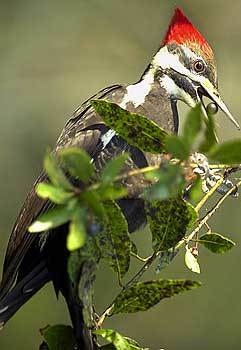If you have heard a woodpecker pecking away at your gutter or home this fall, it may not mean you have insects in your wood.
Connecticut is home to seven species of woodpeckers that live in forests, woodlands, orchards, residential areas and city parks, according to the state’s Department of Energy and Environmental Protection. The birds play an important part of the ecosystem and help control insect populations. They also create nest cavities that are used by other birds and mammals.
The downy woodpecker, hairy woodpecker, yellow-bellied sapsucker, northern flicker, Red-bellied woodpecker, pileated woodpecker, and Red-headed woodpecker are all native to the state, according to DEEP. Predators, including hawks, owls, snakes, raccoons and starlings, eat adult woodpeckers and eggs.
While an important native bird species, woodpeckers also can cause problems around homes primarily due to drumming and drilling activities, according to DEEP.
Both are related to breeding and territorial behavior and may occur in fall or spring. Spring is the most active period as woodpeckers are both drumming and drilling. Drumming by the male is a territorial behavior done to attract a mate and establish a territory. Male woodpeckers drum on surfaces by “lightly” tapping with their bill to create a fast, reverberating drumming sound.
Typically, the drumming surface is a hollow tree, but woodpeckers may also use metal gutters, chimney flashing or aluminum or wood siding, according to DEEP. Drumming rarely results in any significant damage to the home, but it can be an annoyance as it can last for several weeks.
What sets woodpeckers apart from other bird species is that they often will tap or drum in order to communicate as well, rather than having just distinct vocalizations, according to the Connecticut Audubon Society. Woodpeckers peck on objects to create sound patterns as a form of communication.
Objects such as hollow trees, logs and stumps are favored for drumming because their resonance increases the strength and volume of the drumming so it can be heard further away. But sometimes metal gutters and wood siding act as “instruments” to communicate because the sound reverberates well, experts say.
The tempo, rhythm, duration, and repetition of drumming patterns vary between different woodpecker species. Because these patterns can be very distinct, they can sometimes be used for species identification, according to the Audubon Society.
Controlling the damages
Almost all birds native to the United States, including their nests and eggs, are protected by a federal law in place since 1918. The Migratory Bird Treaty Act protects more than a thousand species of birds, including woodpeckers.
In Connecticut, it is illegal to harm, kill or disturb woodpeckers, their nests or their eggs without a specific permit. This applies to all woodpecker species, and while property damage can be a problem, removal is restricted and should often be handled by licensed wildlife professionals who can use legal, non-lethal deterrents or, in specific situations, a depredation permit.
Officials say one of the first and easiest methods of controlling woodpecker damage involves frightening the birds using visual deterrents as well as loud noise. One effective strategy is to hang shiny, flashy or threatening-looking objects that move, such as bird “flash” tape, bird control balloons, wind socks, pie plates, compact discs or plastic twirlers, according to DEEP.
Loud noise may also aversively condition woodpeckers to avoid the area. Sharp, loud noises such as hand or board clapping, and shooting a starter or cap pistol, may be frightening to these birds.
Electronic distress call systems that use a recording of a woodpecker in distress followed by the call of a predator, such as a sharp-shinned hawk, can also be effective. The calls are broadcast through a speaker at various intervals to frighten woodpeckers away from the house. Another option is to attach a movement detector to damaged areas that makes noise when it senses movement.
In addition to frightening the birds away from a home, bird netting or protective aluminum or vinyl siding is recommended for homes that are experiencing repeated damage from woodpeckers. Both of these methods provide a permanent long-term solution to damage, officials say. Bird netting can be attached to the eaves and angled back to the siding below the damaged area. When installed properly, netting is barely visible from a distance.
DEEP officials say that homeowners should think twice before cutting down dead and decaying trees on a property. These trees supply woodpeckers with nesting, drumming and food sites. However, if a dead tree poses a safety hazard to people and buildings, it should be removed.
Removal of woodpeckers causing severe property damage, either through trapping or shooting, is sometimes justified but can only legally be done with a federal depredation permit issued by the U.S. Fish and Wildlife Service, according to DEEP.
In situations where non-lethal attempts to control damages have been attempted and failed and damages are substantial, a permit to trap or shoot a limited number of woodpeckers may be obtained.
Further information on the use of trapping or shooting as woodpecker control methods may be obtained by contacting the Wildlife Division at 860-424-3011 or the U.S. Fish and Wildlife Service at 413-253-8641 or www.fws.gov.
Stephen Underwood can be reached at sunderwood@courant.com.

